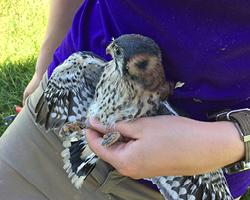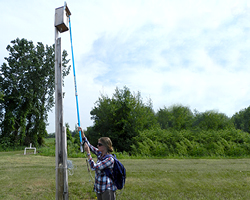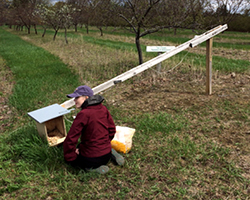American Kestrel Nesting Boxes Keep Falcons Productive Partners for U.S. Fruit Farmers

A field technician prepares to band a young American kestrel who is nearly old enough to leave the nest box.
- Catherine Lindell, Ph.D.
- Associate Professor, Department of Integrative Biology
- College of Natural Science
Anyone with a backyard vegetable garden knows that nature is always trying to get at your plants. Moles, chipmunks, ground hogs, rabbits, raccoons, deer, and a million insects see your hard work as an all-you-can-eat buffet. Farmers have faced the challenge of natural pests since the beginning of agriculture. For Michigan cherry and blueberry growers, some of the most persistent pests are birds—starlings, grackles, American robins, and jays are just a few of the birds drawn by ripe sweet fruit.
These birds can have a dramatic impact on an orchard's yield. Not only do birds eat the crop, they also peck at fruit and leave it behind. Growers then have to invest time in picking out the damaged fruit or suffer a reduction in grade when it comes time to sell. This costs them time and money. Studies have shown that "managing bird damage prevents between $53 million and $65 million in annual losses to grower revenue in Michigan."
For years, Michigan blueberry and cherry growers used a chemical called Mesurol to repel birds. Sprayed on fruit, the chemical gave birds a stomach ache, dissuading them from returning to feed again. (The repellent is produced these days by Bayer and is used, among other things, to deter birds from feeding on maize seeds.) In the late 1980s, however, the producer of the repellant dropped the registration for blueberries and cherries, and growers were forced to find new ways to protect their crops.
Catherine Lindell, associate professor of integrative biology with the College of Natural Science, learned about the ongoing problem growers had with pest birds, and she heard from blueberry growers in the Pacific Northwest that installing nest boxes to attract American kestrels was reducing pest bird abundance in their orchards.
Lindell came to MSU in 1998 and developed a lab that investigates bird behavior and the role birds play in the ecology of managed ecosystems. Much of her research looks at tropical birds and tries to identify features that attract them to tropical forest restoration sites. Birds perform important ecological functions that are necessary for successful forest restoration. They disperse seeds, pollinate plants, and eat destructive insects. Though very different from an orchard in northern Michigan, these tropical sites are also managed ecosystems.

Graduate student Melissa Brady reviews a kestrel box up high in a Michigan blueberry field.
The American kestrel is the most common falcon in North America, and Michigan growers originally introduced nesting boxes in their orchards to combat another pest, voles. Voles are small rodents that consume the bark of young trees, effectively killing cherry saplings. They also damage tree roots. The introduction of kestrels did not necessarily curb vole activity, but growers began to report a decrease in pest birds.
Some growers were convinced the strategy was a success, but if kestrels were to be a potential tool that other growers could use, data were needed. Lindell, herself, was originally doubtful.
"We were skeptical because kestrels mainly eat insects, but we decided to look at kestrel nesting boxes," she said.
With funding from the USDA Specialty Crop Research Initiative, Lindell began erecting kestrel nest boxes near cherry orchards in the Grand Traverse Bay area in 2012. Megan Shave, Lindell's graduate student, then made regular surveys of the orchards—walking between rows of trees, counting birds—to determine bird abundance. They found that kestrels seemed to readily take to the nesting boxes in northern Michigan.
"We were really pleased by how many kestrels nested in the boxes we put up in the Grand Traverse area—we had over 80 percent occupancy," she said. "We then found that while kestrels do eat some birds, they end up scaring away even more birds. So, it's true: cherry orchards with kestrels have fewer fruit-eating birds than orchards without kestrels."
When the USDA funding ended, the National Science Foundation funded Lindell's lab to expand the work beyond cherry trees in northwest Michigan to blueberry fields in southwest Michigan. The project also benefited from the support of the Cherry Marketing Institute and the Michigan Grape and Wine Industry Council.

Graduate student Megan Shave checks a kestrel box in a Michigan tart cherry block.
So far, boxes that have been set up in blueberry fields in Van Buren and Allegan Counties have been less successful at attracting the falcons—only about 33 percent are occupied. There are a number of reasons why this might be. Southwest Michigan is a very different place ecologically than northwest Michigan, and early placement of kestrel boxes in the Grand Traverse region, in the 1990s, may have increased the background kestrel population. But enough kestrels have settled in for the project to begin determining pest bird abundance in blueberry fields, and so the work continues.
One of the growers who has been involved in the kestrel box project from the start is Jim Nugent, a former district horticulturist for northwest Michigan with MSU Extension (MSUE). He retired in 2006. Nugent comes from a family of fruit growers and has his own 42-acre orchard near Suttons Bay where he has been growing sweet and tart cherries since 1986.
In the early 1990s, when he was with MSUE, he arranged for a consultant to talk to local farmers about using falcons for pest control. He then became one of the first growers to build a kestrel box to control voles in his orchard. When the fruit came to maturity, after the kestrels had established themselves, he noticed a decrease in damage from pest bird activity and saw fewer birds in general. His orchard was also one that was used by Lindell's project for data collection.
Though the project seems simple from the outside, Nugent was able to speak to the inherent complexity of the task Lindell and her team has tackled. Ideally, he explained, an orchard would be divided up into sections so that the impact of nesting kestrels could be measured in near identical conditions, under controlled conditions. But kestrels have a wider range than half an orchard, so researchers needed to find various sites that were both distant from each other, yet very similar.
"I was never able to quantify just how much of an impact my kestrels were having on vole control or bird control," he said. "All I could say was that in those years between when we lost Mesurol and I got the box put up and kestrels nesting in the box, I had a lot more problems with birds.
"What Catherine's research has done is give us some numbers, comparing blocks that had kestrel boxes and blocks that did not. So it's been really helpful to get that data, and it's getting talked about more."
Another benefit of using kestrels for bird management is that research from Dr. Phil Howard's group in the Department of Community Sustainability shows that consumers like the idea of natural pest control. Nugent suspects that growers who sell directly to the public through farm markets and u-pick operations can use their use of kestrel boxes as a way to promote their produce.
The kestrels themselves may also be beneficiaries of the project. While the American kestrel is very common, their numbers have been in decline for a number of years. Nesting boxes may just help fight that decline.
- Written by Matt Forster, University Outreach and Engagement
- Photographs courtesy of Catherine Lindell, College of Natural Science